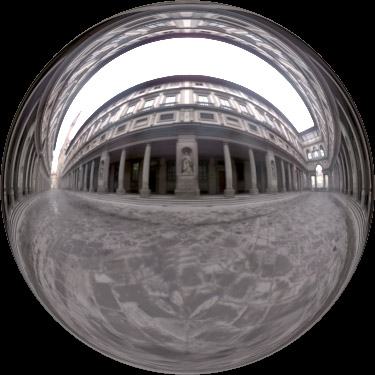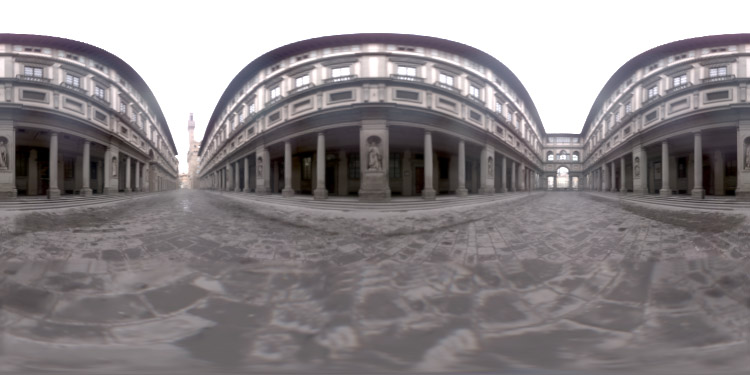
|

|
| Mirrored Ball (360x360 degrees) | Mirrored Ball 180 Degree Close-up |

|

|
| Angular Map (Used in the Light Probe Gallery ) | Cube Map (Vertical Cross) |

|
|
| Latitude/Longitude | |
HDR Shop can be used to resample panoramic images between the following formats:


Mirrored Ball (360x360 degrees) Mirrored Ball 180 Degree Close-up 

Angular Map (Used in the Light Probe Gallery ) Cube Map (Vertical Cross) 
Latitude/Longitude
This tutorial explains how to resample a "mirrored ball" panorama into "cube map" format. Click here to download a high dynamic range version of the Uffizi panorama (above) in a mirrored ball format.
Once you have your mirrored ball image loaded in HDR Shop, choose "Panoramic Transformations…" from the menu, under "Image", "Panorama". The following dialogue will pop up:
The Source Image box should have your mirrored ball panorama selected. If the correct filename is not there, click on the down arrow at the end of the field and select the correct file from the list that appears. The list contains only files that are currently open in HDR Shop. You should also select the source image format; in this case the default "Mirrored Ball" is correct.
The Destination Image field is best left alone. If you choose one of the files instead of "New Image", that image will be overwritten by the result of the panoramic transform. Select "Cubic Environment" as the destination image format. You can also change the destination resolution by changing the Width and Height boxes.
The sampling box allows you to choose a super-sampling pattern, as well as toggling bilinear interpolation. Increasing the super-sampling helps remove aliasing (jaggies). This is especially useful if you are creating a small panorama from a big panorama. Note that the number of samples used is actually the square of the number entered; so if you enter a 3, then HDR Shop will calculate 9 samples per pixel. Bilinear Interpolation, on the other hand, helps most when you are going the other way, creating a big panorama from a small one, though it doesn't hurt to leave it on otherwise.
The 3D Rotation box allows you to rotate the environment, either through an arbitrary rotation (about the x, y, and z axis), or by attempting to match points in one panorama to points in another panorama. Again, lets just use the default, 'None'.
When all your settings are correct press the OK button and HDRshop will resample your mirrored ball image into a cube map.